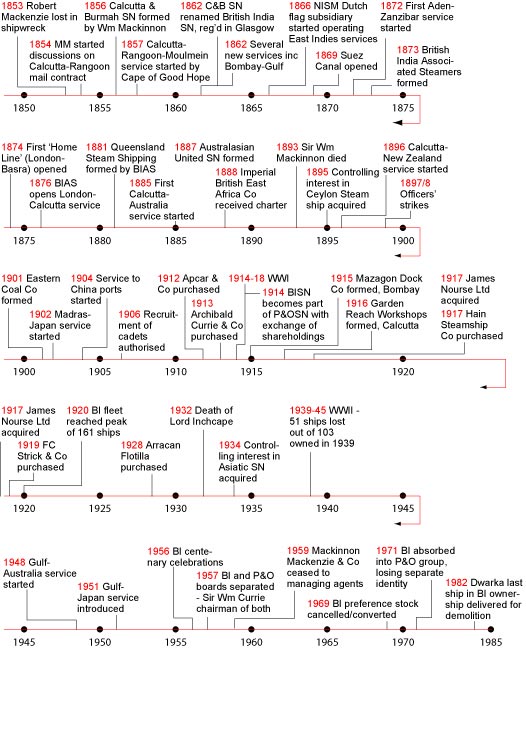British-India Steam Navigation Company
Brief history
British India Steam Navigation Company was formed in 1856 as the Calcutta and Burmah Steam Navigation Company. The company had been formed out of Mackinnon, Mackenzie & Co, a trading partnership of the Scots William Mackinnon and Robert Mackenzie, to carry mail between Calcutta and Rangoon. It became British India SN Co in 1862. Under the hand of Lord Inchcape (James Mackay) who had become chairman in 1913, the company became part of the P&O group of companies in 1914 through a complex amalgamation, but continued with its own identity and organisation for another nearly 60 years until 1972, when it was entirely absorbed into P&O.
As one of the largest shipowners of all time, the company owned more than 500 ships and managed 150 more for other owners. At its height in 1922, BI had more than 160 ships in the fleet, many built on Clydeside, Scotland. The main shipping routes of the line were: Britain to India, Australia, Kenya, Tanganyika. The company ran services from India to Pakistan, Ceylon, Bay of Bengal, Singapore, Malaya, Java, Thailand, Japan, Persian Gulf, East Africa and South Africa. BI had a long history of service to the British and Indian governments through trooping and other military contracts. In the last decade of its operational existence BI carried thousands of school children on educational cruises.
Some of the company's more famous passenger ships included SS Rajula, HMT Dunera, SS Scindia, SS Sirdhana, SS Leicestershire, SS Dwarka and the sisters SS Kampala / SS Karanja (1947/48) also SS Kenya / SS Uganda (1951/1952).
SS Nevasa of 1956 was the final passenger vessel built for BI. Serving as a troopship until redundant in 1962, Nevasa was assigned new duties with the BI educational cruise ship flotilla until 1974, when she became surplus and was scrapped in 1975. Having earlier been joined in this trade by the more economic Uganda, this highly popular vessel was taken up by the British Ministry of Defence in 1982 as a hospital ship during the Falklands war with Argentina. Returning to BI's tradition of government service again in 1983 - this time as a troopship - SS Uganda was "the last BI" when finally withdrawn in 1985. SS Dwarka holds the distinction of closing British-India's true "liner" services, when withdrawn from the company's Persian Gulf local trades in 1982, in her 35th year.
Company timeline
External references
- BI Ship site
- A Short History of British India Steam Navigation
- Clydeside built BI ships
- The Last Blue Water Liners by William H. Miller, Conway Press, London, 1986 - ISBN 0 85177 400 8
| 25px | This article related to a ship transport company is a stub. You can help Ship Spotting World by expanding it. |
| 30px | This Indian history-related article is a stub. You can help Ship Spotting World by expanding it. |
de:British India Steam Navigation Company pt:Companhia de Navegação a Vapor Anglo-Indiana

